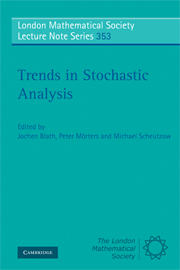Book contents
- Frontmatter
- Contents
- Preface
- Heinrich von Weizsäcker's students
- Heinrich von Weizsäcker's publications
- I Foundations and techniques in stochastic analysis
- II Construction, simulation, discretization of stochastic processes
- III Stochastic analysis in mathematical physics
- IV Stochastic analysis in mathematical biology
- 12 Measure-valued diffusions, coalescents and genetic inference
12 - Measure-valued diffusions, coalescents and genetic inference
Published online by Cambridge University Press: 05 March 2012
- Frontmatter
- Contents
- Preface
- Heinrich von Weizsäcker's students
- Heinrich von Weizsäcker's publications
- I Foundations and techniques in stochastic analysis
- II Construction, simulation, discretization of stochastic processes
- III Stochastic analysis in mathematical physics
- IV Stochastic analysis in mathematical biology
- 12 Measure-valued diffusions, coalescents and genetic inference
Summary
Abstract
We review recent progress in the understanding of the interplay between population models, measure-valued diffusions, general coalescent processes and inference methods for evolutionary parameters in population genetics. Along the way, we will discuss the powerful and intuitive (modified) lookdown construction of Donnelly and Kurtz, Pitman's and Sagitov's ∧-coalescents as well as recursions and Monte Carlo schemes for likelihood-based inference of evolutionary parameters based on observed genetic types.
Introduction
We discuss mathematical models for an effect which in population genetics jargon, somewhat orthogonal to diffusion process nomenclature, is called “genetic drift”, namely the phenomenon that the distribution of genetic types in a population changes in the course of time simply due to stochasticity in the individuals' reproductive success and the finiteness of all real populations. We will only consider “neutral” genetic types.
This contrasts and complements the notion of selection, which refers to scenarios in which one or some of the types confer a direct or indirect reproductive advantage to their bearers. Thus, in the absence of demographic stochasticity, the proportion of a selectively advantageous type would increase in the population, whereas that of neutral types would remain constant. The interplay between small fitness differences among types and the stochasticity due to finiteness of populations leads to many interesting and challenging problems, see e.g. the paper by A. Etheridge, P. Pfaffelhuber and A. Wakolbinger in this volume.
- Type
- Chapter
- Information
- Trends in Stochastic Analysis , pp. 329 - 364Publisher: Cambridge University PressPrint publication year: 2009
- 21
- Cited by



